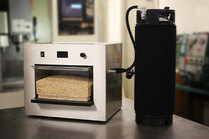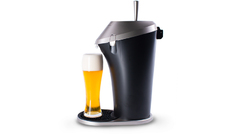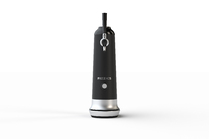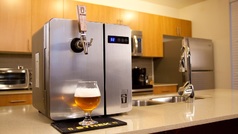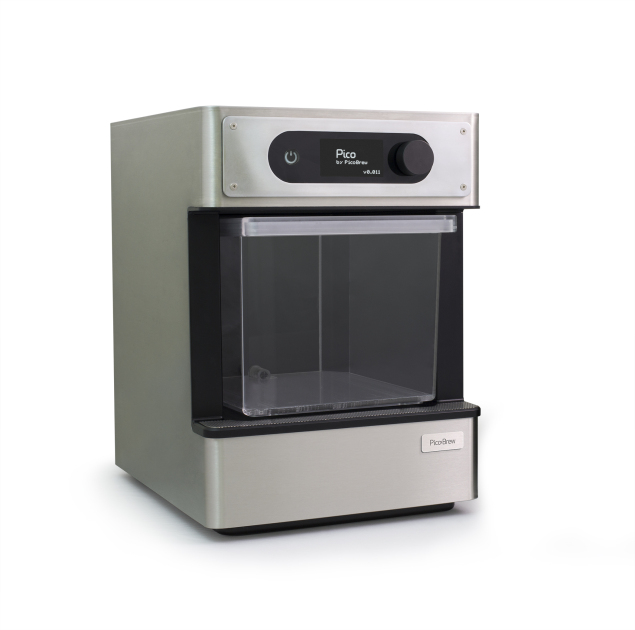
[ad_1]
As a home brewer I can tell you that making your own beer is not easy nor is it cheap, but it is rewarding. To do it right you have to be prepared to spend the better part of a day on prep and brewing, and a fair amount of money on equipment and ingredients. You then you have to wait a week or two for fermentation before you can bottle or keg your finished product. And let’s not forget cleanup. With the Pico Home Brewing System from PicoBrew ($799), you can brew a batch of suds in around two hours without having to worry about home brewing essentials like stirring, adding ingredients, or maintaining a constant temperature. It’s a cool-looking smart home appliance that’s easy to use, but there’s still a fair amount of prep and post-brew cleaning required, and you’ll only end up with a little more than a gallon of beer when it’s all said and done. And while the Pico makes very good beer, $800 is a hard price to swallow.
Design and Features
The stainless steel Pico Home Brewing System looks similar to its pricier sibling, the PicoBrew Zymatic . It measures 16 by 12 by 14 inches (HWD) and weighs 24 pounds. While smaller than the Zymatic (17 by 21 by 15 inches), it still requires a fair amount of counter space. In addition to the machine itself, the Pico system comes with a brewing keg and keg cozy, a serving keg, metal and rubber brewing keg lids, a CO2 regulator, a hops cradle, assorted cleaning brushes, wands, and adapters, and a detailed instruction manual that walks you through the entire preparation, brewing, kegging, and cleanup process. It’s a good idea to keep the manual nearby while brewing.
The system also comes with a PicoPak of your choosing. PicoPaks(Opens in a new window) are pre-packaged, pre-measured kits developed by dozens of breweries from around the globe. They are packaged in a biodegradable container and contain the exact amount of grain and hops needed to brew the recipe. They cost anywhere from $19 to $27 and have an ID tag the Pico machine reads to identify the beer and call up its recipe. They also include a yeast packet and a CO2 cartridge for forced carbonation, a carbonation sugar packet, a stick on temperature gauge, and depending on the recipe, dry hop sachets.
Similar Products
The front of the brewer holds a clear removable 7.5-by-9.2-by-13.5-inch step filter and lid, and above that is a 2.5-by-1.5-inch LCD panel, a control knob, and a power button. Pressing the control knob launches the menu system with choices for Brew PicoPak, Sous Vide, Utilities, and Settings. Pressing the Brew PicoPak option walks you through the entire brewing process, and Sous Vide lets you set the water temperature and cooking time. The Utilities menu contains options for First Rinse, Rinse, Deep Clean, Rack Beer, and Drain Step Filter, and the Settings menu is where you go to select a language and temperature units and to configure network settings.
At the top of the machine is black lid that covers a water reservoir, and at the back is a power cord. The right side of the Pico holds two hoses with ball lock connectors; the black connector goes to the Out post on the brewing keg and the gray connector goes to the In post. As with the Zymatic, the Pico uses 802.11b/g Wi-Fi to connect to your home network but lacks a mobile app. However, it does offer the same Web portal where you can track the progress of each brew in a colorful timeline and temperature chart and share your brewing experiences with fellow Pico owners. Here you can also find recipes that show you how to use the Pico for Sous Vide cooking. (For more on sous vide cooking, see our review of the Anova Culinary Precision Cooker Wi-Fi ($199.99 at Amazon)(Opens in a new window) ).
Setup, Brewing, and Results
Before starting my first brew I went through all five boxes to verify that I had everything I needed. I then followed the instructions for configuring the machine for Wi-Fi, creating an account, and entering my Pico code to register it. Next, I prepared the Pico for its first rinse. I washed the brewing keg, keg seal, step filter, and lid with tap water and added half a gallon of distilled water to the reservoir. I slid the step filter and lid into the slot, added around two inches of water to the brewing keg, connected it to the hoses, and sealed it with the black rubber keg seal. I set the control knob to Utilities and selected First Rinse. When the rinse was completed (around five minutes), I connected a keg wand to the black hose and followed the on-screen instructions to pump the rinse water out of the reservoir and into the step filter. Once the reservoir was empty I cleaned out the inline filter and rinsed the brewing keg, step filter, keg wand, and lid with tap water. It was now time to brew.
My Pico came with a Deaf Turtle IPA PicoPak, which is a clone of Russian River’s Blind Pig IPA. It’s an American IPA that uses four kinds of hops and has a 6.4-percent ABV. I placed the hops pack in the hops cradle, placed it in the step filter along with the grain pack, covered it with the lid, and inserted the filter into the slot on the Pico machine. I then added one gallon plus six cups of distilled water to the brewing keg, sealed it with the rubber seal, slid the cozy over the keg, and attached the hoses to the keg’s In and Out posts. Next, I filled the reservoir with one gallon of distilled water, covered it, and turned on the machine. The Pico read the PicoPak’s ID tag and displayed Deaf Turtle on the LCD panel. I selected Start Brewing and pressed the knob, and the Pico began the brewing session. You don’t have to stick around during the brew, which is a good thing because it does get a little noisy. I checked the brewing progress online and was able to see how much time had passed and when the brew would be completed. This particular beer took 2 hours and 25 minutes to brew.
When the brew was finished I disconnected the hoses from the keg, placed a stopper in the keg seal to make it airtight, removed the cozy, and attached the temperature sticker to the side of the keg. At this point the keg can sit overnight to cool down before adding the yeast. I set about cleaning the step filter by removing the PicoPak and dumping it into my compost bin. I rinsed the filter and lid with clean water, filled it with an inch of water, and inserted it into the Pico. I connected keg wands to both hoses, directed the hose with the gray ball lock into an empty bucket, and used the control knob to begin a rinse cycle and to pump water from the reservoir. After about 10 minutes the reservoir was empty and the Pico was clean. To finish up I cleaned out the inline filter and rinsed the wands, step filter, and lid one more time.
There are two options you can use to ferment your beer. The fast fermentation method (4-5 days) uses a special metal keg lid and must maintain a temperature somewhere in the 70-84 degree range. Standard fermentation (10-12 days) uses the rubber seal with an airlock and can ferment at around 65 degrees. I used the Standard method, making sure the temperature sticker read 65 degrees before adding the yeast and attaching the airlock. After three days I opened the seal and added the hop sachets, which are like tea bags containing hops and are used for dry hopping. I waited another 10 days for the airlock to stop bubbling and was ready to rack the beer into the serving keg and begin carbonation.
I connected the racking tube to the Out post of the keg and the hose with the gray ball lock to the In post. Once the tube was placed inside the serving keg, I selected Rack Beer from the Utilities menu, pressed the knob, and waited around 10 minutes while the beer was transferred from the brewing keg to the serving one. When the racking tube began filling with air I removed it and shut down the Pico. I connected the CO2 cartridge to the CO2 regulator, placed a Carbonation adapter in the hole of the serving keg, and attached the regulator to the adapter. I adjusted the pressure to 24 PSI and placed the keg in my refrigerator for the requisite 36 hours. After 36 hours I turned off the regulator, removed it, and replaced it with the Dispensing plug. It was finally time to drink up.
The Deaf Turtle IPA was absolutely delicious. The keg delivered a clear glass of beer with a foamy head and a nice hoppy aroma. I didn’t have a bottle of Blind Pig handy to compare, but I’ve had it in the past and this recipe was spot-on. My only complaint is that I only had a little more than a gallon of beer for my efforts (I usually make five gallons when home brewing).
The folks at PicoBrew recommend a thorough cleaning, in addition to the steps mentioned above, after each brew session. This involves removing the brewing keg posts, o-rings, and springs with a wrench, brushing them clean, and soaking them in a sanitized solution along with any other parts that were exposed to beer during the fermentation process. You should also clean and sanitize the serving keg and adapters when the beer is all gone. It’s a time-consuming process, but a necessary one that has to be performed whether you use a Pico or a traditional steel pot, fermenting bucket, and carboy for home brewing.
Conclusions
While it’s easy to liken the Pico Home Brewing System to a Keurig coffee brewing system, it’s not an accurate comparison; Keurig coffee requires no preparation or cleanup, and your coffee is ready to drink in minutes. Although the Pico will brew your beer in around two hours, you still have to prep the machine, wait for the brew to ferment, rack the beer into a keg, and wait for it to carbonate. Cleanup takes some time, and must be done right to ensure the integrity of your next batch. All told you’ll have to wait around one week before you can sample your suds, depending on the type of beer and fermentation method used. More complex beers will take longer.
That said, the Pico makes excellent beer, and is very easy to use when compared with a typical home brewing routine. My biggest gripe with the Pico, other than its lofty price, is that it only makes 1.3 gallons of beer at a time, or roughly two growlers. In my house, that won’t last very long. If you want a higher yield and more control over how your beer tastes, consider the Grainfather all-in-one brewing system. It’s not automatic like the Pico and Zymatic systems and requires lots of hands-on involvement while brewing, but it produces incredible beer, and lots of it.
3.5
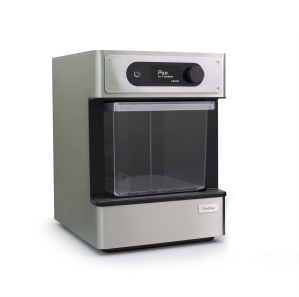
(Opens in a new window)
(Opens in a new window)
View More
View More
The Pico Home Brewing System is a do-it-yourself connected beer brewing appliance that makes delicious beer in around two hours. It’s easy to use but not so easy to clean, and it’s very expensive.
[ad_2]
Source link : https://www.pcmag.com/reviews/pico-home-brewing-system

